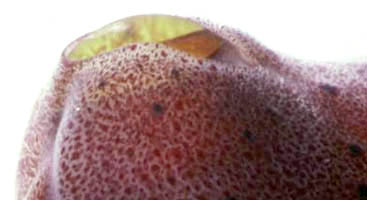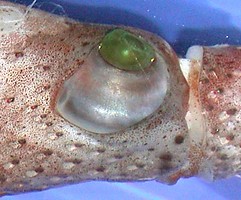The large upward-looking eye of histioteuthids frequently have a yellow tint (as do the lenses of some deep-sea fishes). The yellow pigment is a color filter that prevents blue-violet light from reaching the retina. This may seem surprising that an animal living in very dim light would block-out some of the little available light. Muntz (1976) suggests that this filter functions to defeat the bioluminescent concealment behavior of potential prey that are not exactly matching the color of the downwelling light. An animal that is counterilluminating by using its ventral light organs to match the faint downwelling sunlight and thereby eliminate its silhouette will be invisible only if its bioluminescence exactly matches the color, as well as the intensity, of the downwelling light. Suppose a potential prey is matching the intensity of the downwelling light but its bioluminescence is a bit too green. A yellow color filter on the eye of a predator would absorb some of the blue downwelling background light but not the bioluminescence. The bioluminescence of the prey will, therefore, will appear to be brighter than the background light, revealing the presence of the prey.



Figure. Left eye lenses of histioteuthids. Left - Ventral view of H. oceani, fresh, showing yellow tint to lens. Photograph by R. Young. Right - Side view of H. bonnellii, fresh but probably dead longer than previous squid and with a damaged lens. The lens has a green tint which, if not due to postmortum effects, indicates that this squid may filter slightly different wavelengths of light than a squid with a yellow lens. Photograph by M. Vecchione.
At nighttime the color filter would be a handicap for the histioteuthid would not be able to see some blue-violet bioluminescent flashes. Visual observation of fresh or living histioteuthids suggests that the yellow tint is variable; sometimes it is easily seen and at other times the lens appears colorless. Perhaps the squid can adjust this filter. If so, this would be very unusual since the lens is a secreted structure. Clearly, research is needed in this area.
The function of the dimorphic eyes in histioteuthids has been examined in much more detail in Thomas et al., 2017.




 Go to quick links
Go to quick search
Go to navigation for this section of the ToL site
Go to detailed links for the ToL site
Go to quick links
Go to quick search
Go to navigation for this section of the ToL site
Go to detailed links for the ToL site